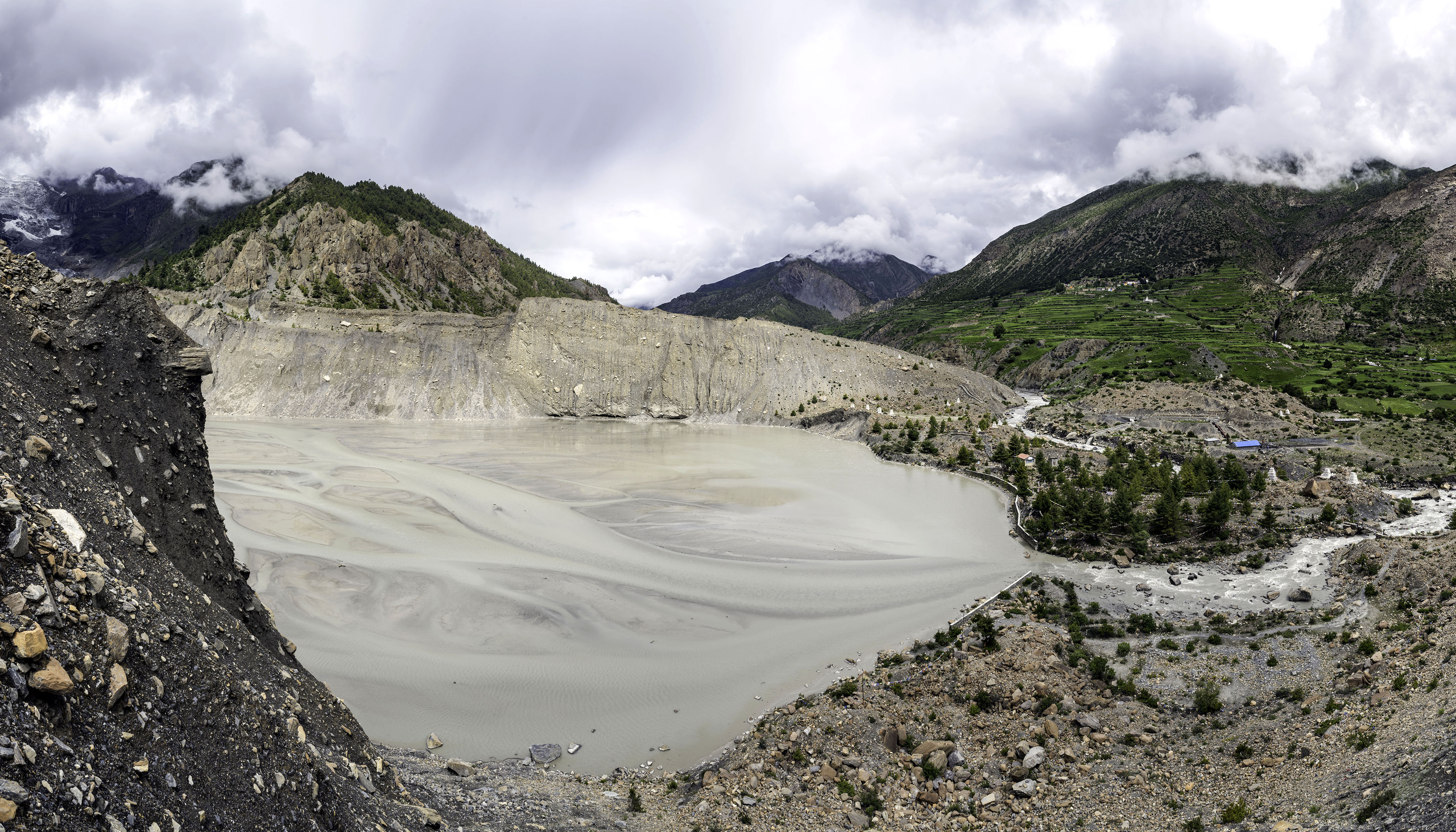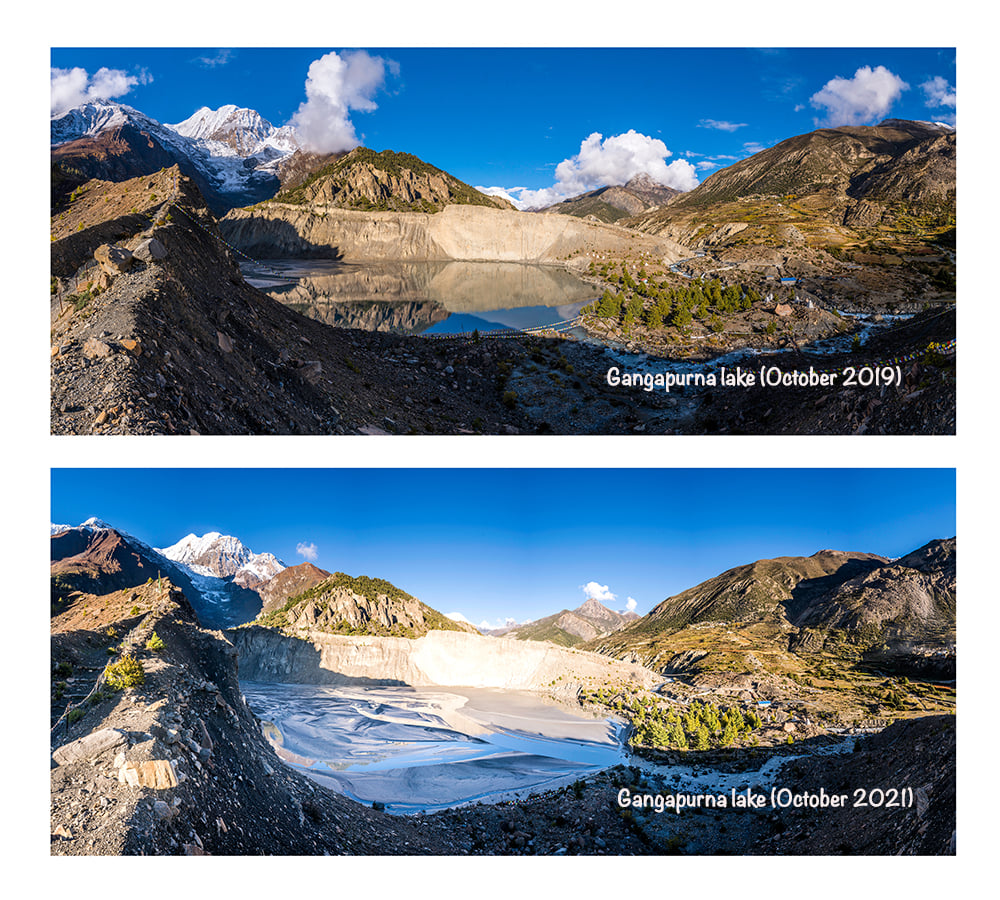
Features
6 MIN READ

Glaciers are retreating across the Himalaya and this is bound to have significant consequences for the ecology of the region and the livelihoods of its people.

Gangapurna lake has always added to Manang’s charm. Set against majestic mountains, the teal glacial lake is a thing of marvel for trekkers on the Annapurna Circuit. But there is no water in the lake anymore; instead, it is a large puddle of grey sludge.
“Unexpected monsoon rains caused many landslides around the lake, which in turn led to a lot of siltation. A lot of smaller landslides were already taking place with the sediment being deposited in the lake bed, which too had already become very shallow. All of these events eventually drained out all the water in the lake,” said Tashi R Ghale, a resident of Manang who works as a wildlife photographer.
Earlier this year, floods and landslides triggered by heavy monsoon rainfall wreaked havoc in several Manang settlements, destroying many homes and displacing hundreds of people. According to The Kathmandu Post, 56 houses were destroyed and more than 200 others were at risk.
But Manang, located in the rain shadow of the Himalaya, never sees such intense monsoons. In fact, the district’s average annual rainfall was barely 300mm; this year, Manang saw nearly double that rain in just one week in June.
While the freak monsoon rain may have contributed to the filling of the lake with debris and sediment from landslides, there are other factors that have played a role too, like global warming. According to the latest Intergovernmental Panel on Climate Change report, because the earth has warmed 1.09 degree Celsius more since pre-industrial times, changes such as glacier melt, which in turn affect glacial lakes like the Gangapurna, are virtually irreversible. What these changes could mean for the ecology and the livelihood of millions who live in these mountains are matters that need more attention.

“We have not looked at this in detail, but in my opinion, this [the drying of the Gangapurna lake] is due to rapid shrinking of the Gangapurna glacier. This has resulted in decreased water flow into the lake,” said Arun Bhakta Shrestha, a senior climate change specialist at the International Centre for Integrated Mountain Development (ICIMOD). “Another reason is sedimentation in the lake, due to sediments delivered by the melt waters.”
The Gangapurna glacier, which feeds the Gangapurna lake, has indeed been retreating at an alarming rate, owing to rising global temperatures. According to a 2020 paper titled ‘Retreating glaciers and Advancing Forest Over the Past 200 Years in the Central Himalayas’, the glacier has retreated by 1.35 percent of its area while its length reduced by 10.56 percent between 1988 and 2019.
“Glacial lakes by nature are not permanent water bodies. They appear and disappear as the glacier moves, so it is not unnatural for a glacial lake to dry up. It is all part of the dynamics of Himalayan ecology,” said Madhukar Upadhya, a river and watershed expert. “However, if such changes are being expedited because of anthropological reasons then that is a cause for concern.”
Back in 2007, the fourth IPCC report stated that glaciers in the Himalaya were receding faster than in any other part of the world due to climate change and global warming. According to the sixth IPCC report, glaciers are projected to lose more than 80 percent of their current mass by 2100.
And with efforts to curb the rising global temperature going nowhere, deglaciation in Nepal and other Himalayan countries is expected to further intensify.
“The lake itself was formed only around the 1960s, after the glacier receded,” said Rabindra Acharya, chief district officer of Manang. “In the past few years, however, the water level started decreasing dramatically and the recent landslides induced by the monsoon rain completely covered up the water.”

A paper titled ‘Adapting in the shadow of Annapurna: A climate tipping point’ states that an increase in glacial runoff from the Gangapurna glacier resulted in the formation of Gangapurna Lake in the first place, citing this phenomenon “as the biggest physical change in the local environment”. But recent years have seen a significant contraction in the size of the lake.
In 2018, The Himalayan Times reported that water in the glacial lake was receding, as sediment was being deposited into the lake with inflowing water at an alarming pace. The report also stated that the lake, which extends to an area of 21.08 hectares, had already lost a third of its depth.
As comprehensive scientific data on Himalayan glaciers and glacial lakes is not readily available, when it comes to the impacts of global warming on the Himalaya, research has largely been limited to scouring the potential for glacier lake outburst floods (GLOFs). The drying up of glacial lakes, however, could be just as concerning, as it influences the ecology of the region. It will especially have serious implications on freshwater reserves in mountain communities.
As glaciers retreat, the amount of meltwater flowing into rivers could decline considerably. And because surface and groundwater systems are interconnected, such a situation can lead to a substantial drop in the level of groundwater in some regions.
Studies conducted by the Indian Space Research Organization (ISRO) show that approximately 75 percent of Himalayan glaciers are retreating at an alarming rate. According to one study, of the 2,323 glacial lakes in Nepal located at elevations of 3,500 meters and above, 20 are considered potentially dangerous. Three of these potentially dangerous glacial lakes have a history of outbursts.
“Things that did not happen in the past are happening right now. That in itself should alarm us,” said Upadhya, the watershed expert. “We really need to understand what is actually happening across the trans-Himalayan range if we are to lessen the damage that has been done.”

Marissa Taylor Marissa Taylor is Assistant Editor of The Record. Previously, she worked for The Kathmandu Post. She mostly writes on the environment, biodiversity conservation and public health.


Perspectives
10 min read
We cannot protect ourselves if we don't protect others. And the time to act is now.
Explainers
21 min read
We have not dealt with a disease like COVID-19 in over 100 years.
Perspectives
9 min read
In addition to building resilience against climate change, we must also come to terms with the trauma it leaves us with.
Features
4 min read
Where the federal government has failed, local governments have stepped in
Features
7 min read
Community forestry has been a global success story for Nepal, none more so than those in the buffer zone of the country’s many national parks.
Features
5 min read
Lucrative but illegal businesses are sprinkled all over the country
Opinions
5 min read
Nepal needs a compulsory environmental curriculum to equip its future citizens to face an impending climate crisis
Perspectives
10 min read
Fossil fuel-enabled developed nations are now realizing that they are not immune to the impacts of climate change, but the worst effects will be--and are being--felt by poorer countries.